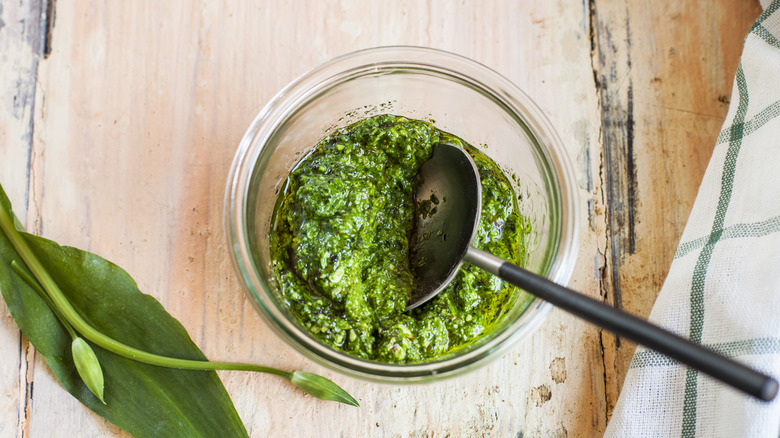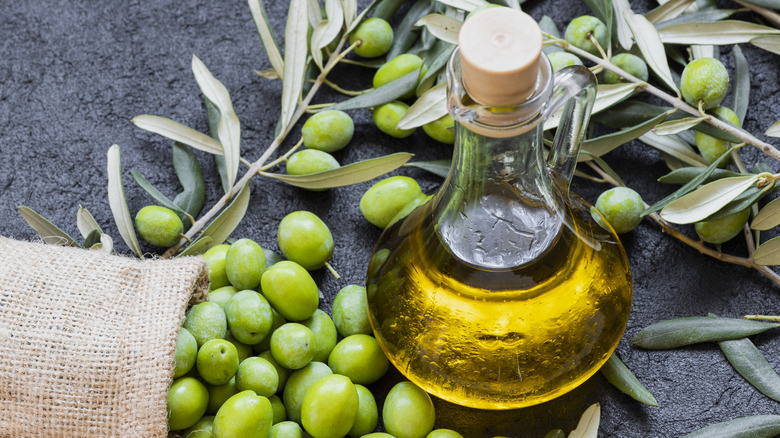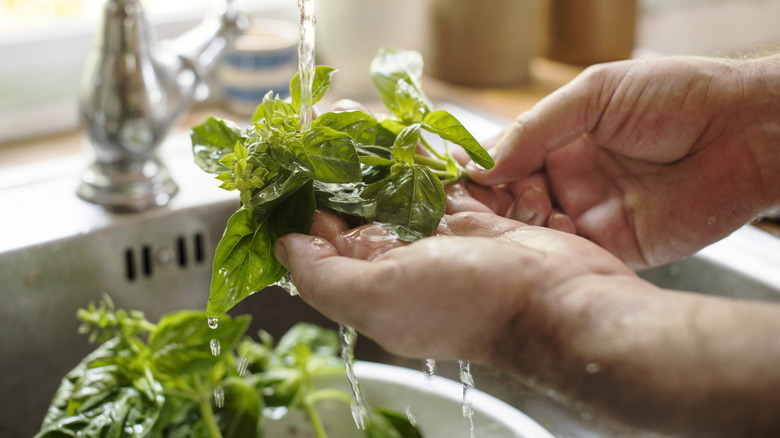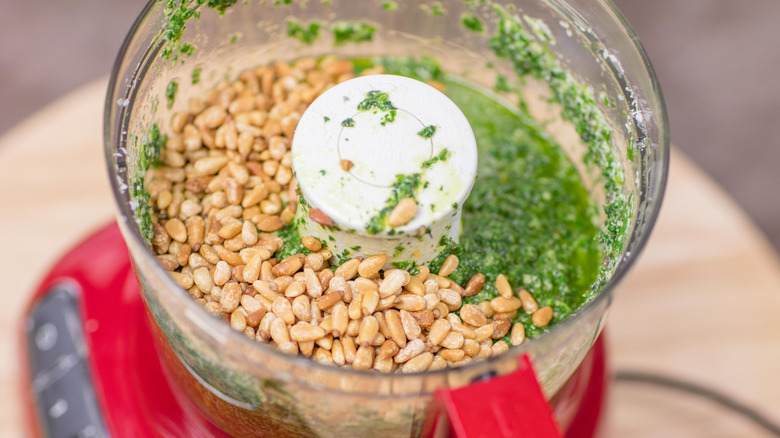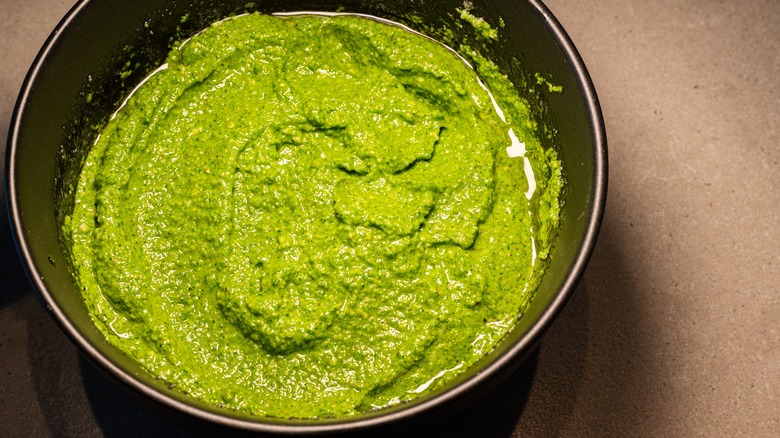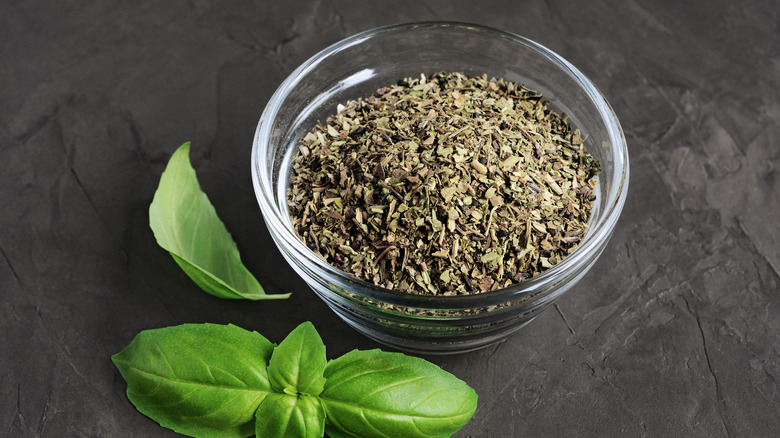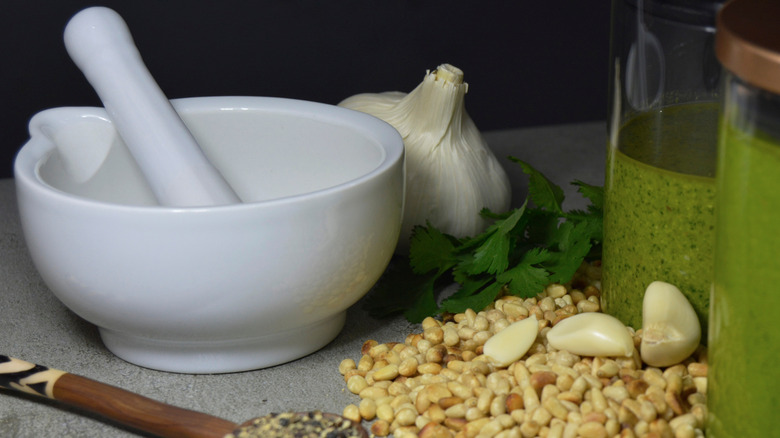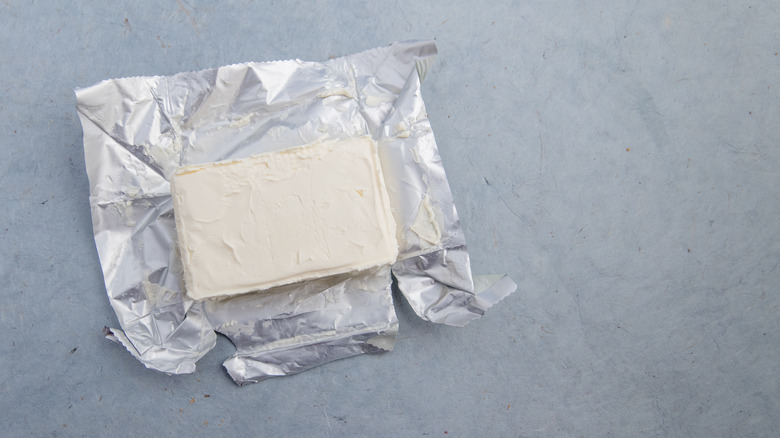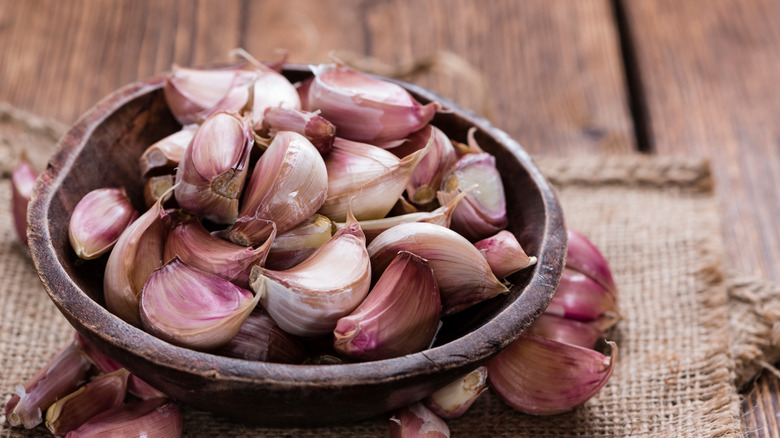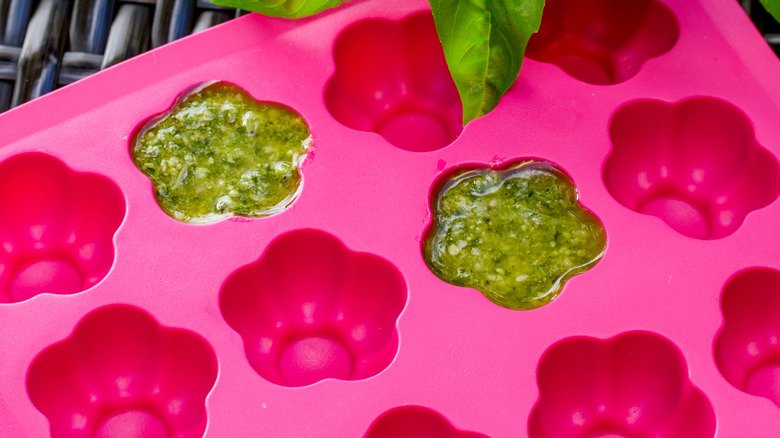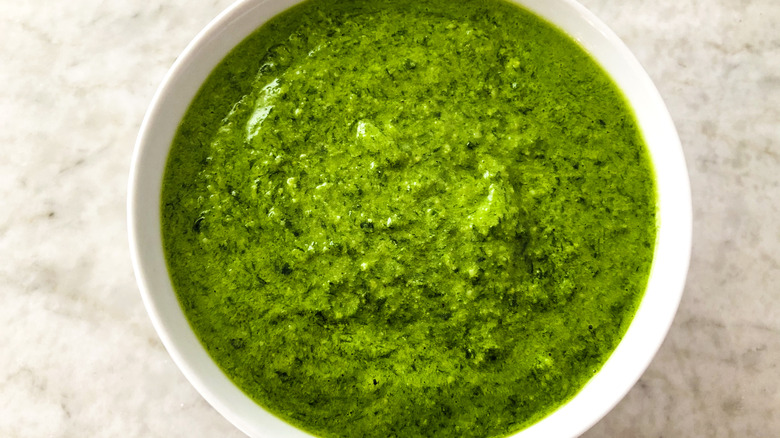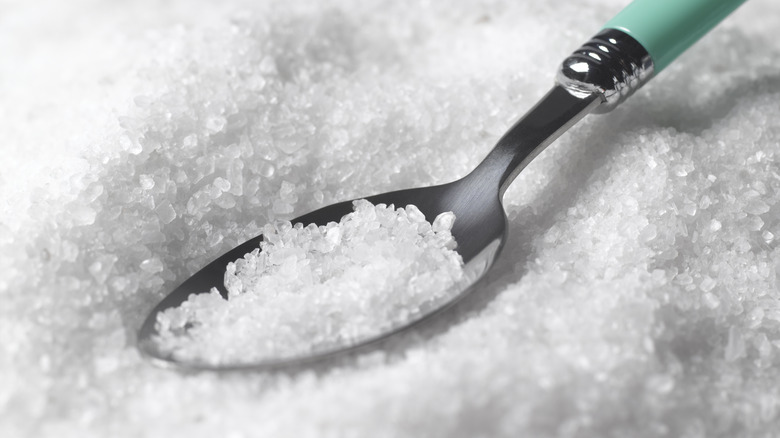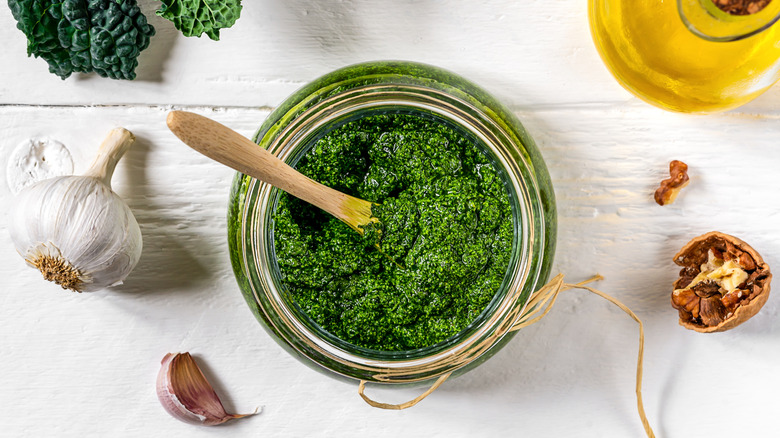14 Mistakes You're Probably Making With Homemade Pesto
Homemade pesto is one of life's ultimate pleasures. With just a few ingredients and a little bit of time, you can make a version of the classic sauce that's worlds apart from the jarred kind. Homemade pesto is bright, fresh-tasting, and very satisfying to make — and it's not just for pasta, either. You can pop it on pizza, stir it into mashed potatoes, and swirl it into soup for an immediately herby, rich flavor.
However, that only happens if you actually get it right in the first place, and that can be harder to achieve than you think. Homemade pesto is one of those things that only requires a few ingredients and steps, but everything on the way needs to be done just right. If you opt for the wrong addition, use slightly too much of a specific component, or do things for a little bit too long, then you may end up with a sauce that's pretty horrible. In reality, homemade pesto needs a lot of love and care, with each stage executed with care and attention. You also need to source the best ingredients you can and ensure that you're preparing them just right. Ready to stop messing things up? We've got you.
1. Mistake: Using the wrong kind of fat
Not all fats are made equally, and one stands head and shoulders above the rest when it comes to pesto: Olive oil. Olive oil is the standard choice for Italian pesto, thanks to its fruity flavor and unctuous texture. Unfortunately, though, a lot of people assume that any old oil will do in its place, so pesto in kitchens around the world is made with substitutes like plain vegetable oil, or even things like coconut oil. Now, don't get us wrong, these will leave you with a form of pesto that might just get you by. However, they won't give your sauce the complex, bright flavor it deserves.
So, we'd always recommend going for the highest-quality olive oil you can find to make pesto. Extra virgin olive oil is best, thanks to its superior flavor. Extra virgin olive oil has those peppery, slightly earthy notes that we all associate with perfect pesto, and while it can be a little pricier, it's worth the expense. If you can't find any, or you just want to use the bottle you've already got open in your kitchen, then the regular kind will still work well.
2. Mistake: Not washing your ingredients
Do you have to wash your ingredients when you're making pesto? Yes. You do. Forgetting to wash your herbs or greens when making pesto is a huge mistake that can ruin your sauce. "Skipping this step will leave you with a sandy, gritty pesto which is quite unpleasant to consume," Makenna Held, CEO of RecipeKirk, told Daily Meal. If you don't wash your pesto, any dirt that's clinging to the greens will just end up in your sauce — and any potential pathogens or pesticides will end up in there, too.
Don't be fooled into thinking that you don't need to wash herbs, either. While they're smaller than spinach or kale leaves, herb leaves are still entirely capable of carrying little pieces of dirt on them that can enter your food. Crucially, after washing your greens, you need to dry them thoroughly before mixing them with the rest of your ingredients. You don't want to add any unnecessary moisture to your sauce.
3. Mistake: Forgetting to toast your nuts
Although you can leave nuts out of your pesto, you'll likely regret doing so. Nuts add a woodsy, earthy counterpoint to the brightness of your herbs and cheese, and they also add to your pesto's fat content, thereby improving its richness. In addition, they give your pesto a delightfully grainy texture and some extra body — and there are plenty of different nuts you can add to the sauce, too.
However, nuts will never achieve their full potential unless you're toasting them. If you add raw nuts to your pesto, it'll have an undeveloped, one-dimensional flavor. Toasting nuts also helps to firm them up and give them extra crunch, whereas raw nuts can end up being a little pasty when blended into a pesto. Therefore, you should always toast your nuts before adding them. The good news is that all you need to do is heat them up in a dry frying pan. The fat content in your nuts will stop them from burning and will lubricate them as they develop their beautiful brown color. Just make sure you allow them to cool before chopping or blending them.
4. Mistake: Making your pesto with basil instead of other herbs
What's the first ingredient that comes to mind when you think of pesto? It's basil, right? Naturally, basil is one of the key components of this sauce, and is arguably the strongest flavor and scent in it, with the other ingredients serving as backup singers to the basil's lead vocals. However, it's easy to forget that you don't actually need basil at all for this sauce. By mixing up your greens and herbs, you can create a twist on pesto that gives the sauce a completely new dimension.
If you want to make a slightly spicier, peppery pesto, try using cilantro instead of basil. Cilantro gives your pesto a slightly more fiery edge, and it works well as a sauce for meats or to create a more exciting pasta dish. For something a little more floral, you can opt for dill, or you could make a parsley pesto which has loads of brightness. Don't forget, too, that you can combine herbs in your pesto to make a brand new creation. Opting for a basil-cilantro pesto, for example, can give you a spicy sauce that still has a lovely fruitiness to it.
5. Mistake: Using old ingredients
Pesto is one of those dishes that people resort to when they have to get through some old stock. If you have some sprigs of basil lying around that are a little past their prime, or some pine nuts sitting at the back of your cupboard, it can feel natural to whiz them up and fork them through your pasta. However, if you do so, you'll end up with a pesto that's pretty terrible. This dish thrives on freshness, and if you're using old ingredients, you're only going to limit its flavor.
It's important to remember, too, that if you stock up on ingredients to make pesto, you'll need to use them pretty quickly. Pine nuts, for example, have a relatively short shelf life of just two to three weeks. After that, they can start to go rancid, giving your pesto a pretty awful flavor. Basil can also go bad pretty quickly, turning from a vibrant green to a black-tinged, soggy mess in just a few days. Using cheese or oil that's past its prime will also have a negative effect on your pesto's flavor. Just buy it fresh, folks; don't disappoint your tastebuds.
6. Mistake: Using dried herbs
Because pesto is a slack, wet sauce that is moistened by the copious amounts of oil in it, it can be easy to assume you can get away with using dried herbs. After all, the oil will add moisture, so you don't have to worry about the herbs being chalky, right? On top of that, don't dry herbs and fresh herbs have the same flavor?
Sadly, neither of these things is entirely true. Although you can technically make pesto with dried herbs, it won't have the same texture as a pesto made from fresh herbs, and it can still have a slightly dry, brittle texture. Additionally, dried herbs don't have the same flavor as fresh ones. They can be a little more bland-tasting and don't have the same vibrant intensity that fresh herbs have. Their flavor profiles can also be pretty different: Dried basil, for example, has a vaguely sweet taste, while regular basil tastes fruity and peppery. If you are going to use dried herbs instead of fresh ones for pesto, it's important to remember that you might need to add less of the dried version than you think.
7. Mistake: Processing your pesto too vigorously
People love pesto because it's so quick. Although the traditional way to make it is with a pestle and mortar, a lot of people these days make it with a food processor. There's nothing hugely wrong with this, and it can produce a solid result. However, one big mistake a lot of people make with their pesto is processing it too vigorously or for too long, which can lead to the sauce becoming mushy, pasty, and containing a somewhat deadened flavor.
The key is not to throw your ingredients in without doing anything first, but instead to slice them up a little. "You have to rough chop, with a large chef's knife, all your ingredients before they go in a food processor," RecipeKick CEO Makenna Held told Daily Meal. If you just pop them in without any chopping first, then you're waiting for your processor to break them all down to equal proportions. Crucially, too, some of your ingredients are more tender than others. Plus, roughly chopping them first ensures that all of your ingredients can access your food processor's blade easily, ensuring equal blending.
8. Mistake: Forgetting the power of a mortar and pestle
In the modern world, most people just opt to use their food processors to make pesto. Well, we're all about making things in an old-school way, folks — and things don't get more old-school than a pestle and mortar. These items have been the tools of the trade for Italian chefs for generations, and plenty of people still use them to make their sauces. They don't do that because they just don't have access to food processors, either: They do it because it results in a better-tasting pesto.
When you use a pestle and mortar for pesto, you're engaging in a more gradual process. Your ingredients are broken down more slowly, which helps them to release their flavors in a more delicate manner. This can result in a more complex, round-tasting sauce. The texture of pesto made in a pestle and mortar can also be better: Because you're mashing and pounding the sauce instead of slicing it with a blade, you can give it an added creaminess. In turn, this improves its mouthfeel and helps it coat food more effectively.
9. Mistake: Using a cheese that's too soft
The cheese in your pesto makes a huge difference. Cheese brings salty, funky, and umami notes to your sauce, turning it from something overly bright and herbal into something that tastes round, full, and rich. However, you need to be seriously careful about what type of cheese you use. For the perfect homemade pesto, you need to avoid soft cheese, as adding it will turn your pesto into a pasty mess.
Soft cheese in pesto seems like a good choice, but you have to think about what will actually happen if you add it. First off, soft cheeses don't blend well with the herbs and nuts in your sauce, and you'll end up with a fairly inconsistent result. Additionally, pesto made with soft cheese has a tendency to slacken and turn soupy when it's heated. Hard cheese is used in pesto for a reason, as it helps the sauce retain its slightly bitty texture, but also melts and provides smoothness when it's heated. On top of this, it blends way more effectively than soft cheese and gives pesto a more direct, intense flavor.
10. Mistake: Adding too much garlic
Garlic makes a pesto sing, with the marriage of the allium plant with herbs and cheese creating a flavor sensation. However, it's incredibly easy to overdo it. A lot of people have bought into the mindset of "more garlic is better" when it comes to pesto, and merrily thrown bulb after bulb into their sauce. Then, they're disappointed when the pesto reeks of garlic, and it's the only thing people can taste.
The key is to be moderate with your garlic additions and to remember that its flavor can and will develop over time. As your pesto sits, the garlic taste will continue to strengthen and overpower things — so only add a little at first. If you do find that your pesto is completely dominated by garlic, then the best thing to do is to add more of the other ingredients to balance things out. Mix them up in a pestle and mortar or food processor without any garlic, and then stir them into the sauce. You may find that doing this gives it a new boost of freshness and life.
11. Mistake: Storing it incorrectly
Homemade pesto is likely one of those things you want to make in a big batch, so you can enjoy some of it later down the line. However, you won't enjoy it much if you store it incorrectly. The herbs in pesto are pretty perishable, and they can decay and turn moldy fairly quickly in your refrigerator, even if you've popped them in a sealed container. The nuts in pesto can also turn rancid over time, ruining its flavor.
If you're keeping your pesto in the refrigerator, the key is to limit its air exposure as much as possible. One of the best ways to do this is to cover your pesto with a thin layer of olive oil, which will act as a barrier between your pesto's ingredients and the air in your chosen container. This will also add an extra pop of flavor to the sauce. Bear in mind, though, that you'll still want to use it within a few days for maximum freshness. The good news is that if you want it at a later time, you can also store that leftover homemade pesto in your freezer.
12. Mistake: Making your pesto too moist
Sauces can come in a range of different consistencies, and most people know that pesto sits on the thicker end of the spectrum. Homemade pesto can be a little looser than the jarred version, but you'll generally want it to be pretty chunky, yet with a slight looseness to it that allows you to pour and spread it easily. Unfortunately, many folks forget that this thickness is key to a successful pesto, and they subsequently throw in too much oil or extra water to thin it out.
While this can be useful for especially thick pestos that aren't blending or pouring properly, generally speaking, you should avoid adding too much liquid. Doing this will ruin the consistency of the sauce, and also dull the intensity of its flavor. Importantly, too, the herbs or greens you add to your pesto have a high water content and will continue to release it as they sit with the saltier ingredients. If you do need to thin your pesto out, it's always better to do so with oil instead of water, as the latter will add no flavor whatsoever. It may also ruin your pesto's ability to adhere to pasta properly.
13. Mistake: Not seasoning your pesto enough
One of the best things about pesto is that it's full of ingredients that are inherently intense and flavorful. Between the bright herbs, the fruity oil, and the umami-packed cheese, it's one of those sauces that doesn't rely too heavily on a load of extra seasonings to make it pop. However, it's a mistake to assume that you don't need any seasonings whatsoever, and without a good amount of salt, your pesto will turn out flat and disappointing.
Salt will help to bring your homemade pesto together and add a final burst of intensity to it. Additionally, it will help to balance any overly acidic flavors in your sauce. Although the cheese you add will have a good amount of salt in it already, it may not be enough, and you want to make your pesto as punchy as possible. Having said this, it's very easy to add just a bit too much salt and override the other flavors with salinity. Make sure you're only adding a little at a time, and taste-testing constantly.
14. Mistake: Forgetting that you don't need herbs at all
Pesto is most commonly made with basil, but you can also knock it together with a host of other herbs. What do you do, though, when you don't have any herbs at your disposal? Is pesto completely off-limits? No, it's not, and it's a mistake to assume it is. Pesto can be made with a host of other greens, which give the sauce a new lease of life and awaken different flavor profiles. Kale pesto, for example, harnesses the slight bitterness and pepperiness of the leafy green but balances it out with oil, cheese, and lemon to give it a rounder profile.
For an ultra-peppery pesto that's slightly lighter, try using watercress as your base ingredient. Broccoli pesto, meanwhile, has a gentle nuttiness and an almost meaty consistency. No greens? No problem. Knock together a red pepper pesto instead, with the peppers giving your sauce a zing that brings pasta to life.
